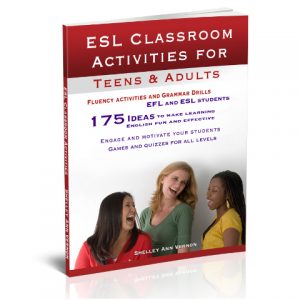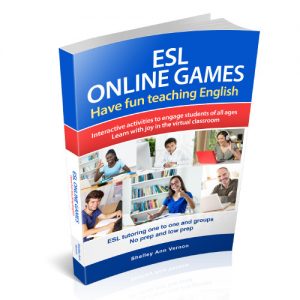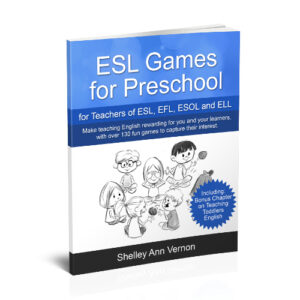A verb to be lesson plan made of games
Use this verb to be lesson plan for the present tense of ‘to be’ and professions vocabulary. This plan is adaptable for one-to-one and groups, whether lessons be online or face to face.
Preparation
Choose six professions that appeal to your pupils. You might prefer to teach realistic, down-to-earth jobs our pupils may do one day, like a plumber, hairdresser, secretary, lawyer, real estate agent, or nurse. Or you might be happy to let kids dream, choosing amazing or glamorous jobs, like astronaut, singer, actor, footballer, artist, or vet. As the teacher, you decide or ask your class to vote on six favourites.
Pictures
Now you have your six professions, it’s time to learn them by heart in English. But first, you need a picture of each one. Your pupils can draw these and send them to you in advance of the lesson, or you can easily find pics online that fit the bill.
Introduce six new words
Use mimes to introduce up to six new words. For example, show a picture of one of the professions and say, ‘plumber, he’s a plumber; plumber.’ Next, ask kids for ideas for a mime that would fit a plumber’s job and have everyone do that action. Next, show the second profession and repeat the process. Finally, show the plumber and elicit the mime, then move to the third profession, establish the mime for that.
Do pictures one, two, and three with the three mimes. Now do picture four, establish the mime, and show jobs 1,2,3 and 4. Move on to jobs five and six in the same way. Build gradually, repeat, and reinforce. There is no point showing all six pictures and assuming that kids will remember them all just like that. Using the mime to enhance the meaning helps kids recognize, understand, and integrate the new word.
Now the new words have been introduced, step up the pace with a second listening game.
Jump the Line
Show the pictures on a screen left and right of a line. Call them randomly using the short phrase ‘he’s an actor,’ she’s a vet, he’s a gardener, and so on. This way, you reinforce the new vocab while introducing the verb to be in the present tense. Kids put out an arm indicating which side of the line the picture is on. Start to jump about in the list. Gradually, get faster and faster. For example, job A, job B, job A, job B, job A, job B, job C! You’ll catch loads of kids out all the while repeating the new vocabulary over and over.
Picture Flashcards
Play a game where you flash pictures fast in front of the camera, sometimes hiding part of the picture. Vary the speed you flash the cards. You don’t want it to be too easy, or there’s no game element. Pupils call out the professions. When students hesitate, show that profession more often, mixed in with the others, until you have thoroughly drilled all six.
Blow your house down
Play in teams. The question each time is; What is he? Or What is she? (But, of course, if you prefer to teach ‘What does he do?’ that is fine.) Show a picture of a profession. The team reply with ‘he’s a …..’ They have to get all six right in a row, or their house is blown down, and they go back to zero. This game works fine with individuals too.
One Lemon
Every game in this verb to be lesson plan works for private ESL tutoring except for One Lemon, which is for groups of six pupils and upwards.
Play One Lemon using professions. This game can take some practise the first time you use it. So first, do a demonstration with six students and then split the class into groups. Use breakout rooms if you are online. Each player has a profession. To allocate these, read each student’s name and say a job. The student concerned repeats the job back to you and makes a note of it. This way, you are sure everyone has a profession and is are participating. Start with:
‘One plumber, half a plumber, calls three painters.’ Immediately, the painter student says: ‘Three painters, half a painter, calls five astronauts.’ And so on. To include all the professions, have a rule that five different jobs must be called before mentioning the plumber.
Boggle
Boggle is a versatile game that fits any theme, including a verb to be lesson plan. Make a boggle with the professions inside and have pupils race in teams to find as many words as they can. Have students search for any English words, but every profession earns double points. Boggles are usually 4 x 4 but bigger ones are easier. The boggle below has these professions, along with many other English words, such as plumber, painter, astronaut, nurse, vet, and artist.
P L U M
B E R A
I N T S
V O A T
Use chanting with rhythms
This activity is for the whole class, on or offline. Since you are teaching ‘to be’ and professions, make a rhyme such as this: I’m a plumber, you’re a painter, he’s a singer, she’s a waiter.
Have everyone say this and clap together on the pronoun. I’m a plumber, you’re a painter, he’s a singer, she’s a waiter. Do this a few times, and it should be quite easy. Next, try a rhythm where you clap on every third syllable. Display the sentence with the bold so kids can see where they are to clap. Expect to take a few attempts before they get this rhythm going. For example:
I’m a plum-ber you’re a – paint-er he’s – a singer – she’s a wait-er.
Finally, use this rhythm, where the “I’m a plumber you’re a” takes the same time as “paint-er.”
I’m a plumber you’re a| paint -er | he’s a singer she’s a | wait -er.
This exercise is fun to do, involves repetition, and is a huge aid to fluency. Once you have worked through those rhythms, it will be super easy for your class to say “I’m a painter” without hesitating. In addition, they will have drilled, “I’m a, you’re a, he’s a, and she’s a.”
Mime and guess
The next game in this verb to be lesson plan has kids moving. To play, put kids in groups and have each group mime one of the professions while the other teams race to guess what job they are doing – calling out, “you are painters!”
Spell and act
Spell and act is a good game for writing and spelling. First, spell one of the professions and have the class mime the job. Then, you can make teams and give forfeits for the losing team if you like. Forfeits are silly things like singing a song, miming a cat, naming a picture flashcard, or drawing something.
Mastermind
Finally, play Mastermind with pupils in pairs. For online lessons, put kids in breakout rooms with use of the annotation tools. If you don’t want to give your group use of the annotation tools then you can’t play Mastermind in groups. Sharing annotation tools is easy with one-to-one tuition and small groups, and I prefer to let my pupils use them because it involves them in the lesson more.
How to play
One player is the code maker, the other the codebreaker. The code maker chooses a pattern of four words. Duplicates are allowed, so the player could choose the same word four times, but this tends to be easier to guess. Blanks are allowed in the classic mastermind game, but not in my spelling version. Finally, The code maker writes down the four words in a specific order.
The codebreaker tries to guess the pattern, of both the word and the order, within thirteen turns. Each guess is made by writing the words on the decoding board. Once a row is done, the code maker provides feedback by copying and pasting coloured circles over the white ones. A red circle indicates one valid word in the right place, but it does not reveal which word is correct. A yellow circle indicates a valid word in the wrong place.
Once feedback is provided, another guess is made; guesses and feedback continue to alternate until the codebreaker guesses correctly or all rows are full. Use Mastermind for any grammar, so here you can use it for to be and jobs.
You get a template with my book of ESL Online Games.
Great lesson planning resources
I hope you enjoy this lesson plan for the present tense of ‘to be’ and professions vocabulary.
For many more games that you may adapt to any grammar or vocabulary, please choose from my selection of games books for different ages and my bumper online ESL games book.
-
Games
Games and Activities for Teens and Adults
Rated 5.00 out of 5€19.97Original price was: €19.97.€15.33Current price is: €15.33. Add to cart -
Games
ESL Games book for primary & middle school children
Rated 5.00 out of 5€19.97Original price was: €19.97.€15.33Current price is: €15.33. Add to cart -
Games
Preschool games book
Rated 0 out of 5€19.97Original price was: €19.97.€11.97Current price is: €11.97. Add to cart
Verb to be lesson plan Help
I’m here to help if you need me. Just drop me an email (see the contact page), or leave me a comment below. (Your email is not shared, you can type in a fake one if you like!)




